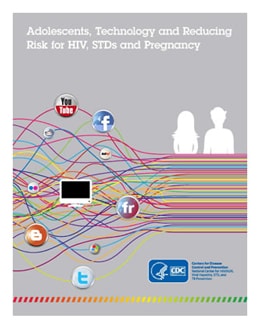Adolescents, Technology and Reducing Risk for HIV, STDs and Pregnancy
Digital technology, including the internet, mobile phones, and gaming, increasingly influences the lives of adolescents. Among youth aged 12-17 years:
These technologies allow youth to engage in age–old behaviors such as chatting, flirting, and dating in novel ways. They also provide youth with anonymous avenues for seeking health information in general and sexual health, in particular.
While technology has changed the way in which teens interact and access information, they remain a vulnerable population when it comes to sexual risk.
- The burden of sexually transmitted diseases (STDs) among people aged 15–24 years accounts for nearly half of all STDs reported in the U.S.3
- The U.S. pregnancy rate among youth aged 12–19 years is one of the highest in the developed world.4

Adolescents are also especially vulnerable to sexual risk because they are undergoing rapid cognitive, behavioral, emotional, and social development. Targeting youth who are using emerging digital technology is important for ensuring sexual health equity for adolescents.
This white paper is intended for practitioners and others who work with adolescents and provides an overview about the ways in which digital technology can be used to improve the sexual health of adolescents. It includes:
- A brief summary of adolescent characteristics, including their demography, development, and sexual behavior
- A basic overview of the new digital technologies and media that youth are using such as social networking sites, video sharing, blogs, instant messaging, mobile technology, and virtual worlds
- An examination of technology’s potential for use in sexual health promotion, as well as the risks associated with misuse of digital technology.
- Examples of innovative adolescent sexual health interventions that have used digital technology to improve their reach and effectiveness.
1. Lenhart, A., Ling, R., Campbell, S., & Purcell, K. (2010). Teens and mobile phonesexternal icon. Washington, DC: Pew Internet & American Life Project.
2. Lenhart, A., Kahne, J., Middaugh, E., Macgill, A. R., Evans, C., & Vitak, J. (2008). Teens, video games, and civicsexternal icon. Washington, DC: Pew Internet & American Life Project
3. Kreisel KM, Spicknall IH, Gargano JW, Lewis FM, Lewis RM, Markowitz LE, Roberts H, Satcher Johnson A, Song R, St. Cyr SB, Weston EJ, Torrone EA, Weinstock HS. Sexually transmitted infections among US women and men: Prevalence and incidence estimates, 2018. Sex Transm Dis 2021; in press.
4. National Campaign to Prevent Teen and Unplanned Pregnancy. (2014, August). Teen Birth Rates: How Does the United States Compare?
